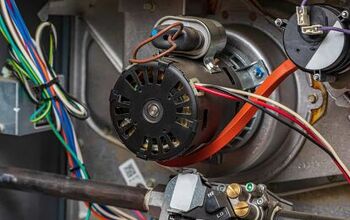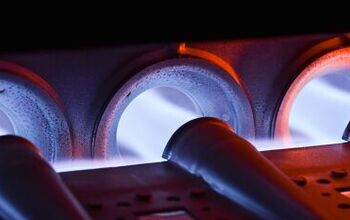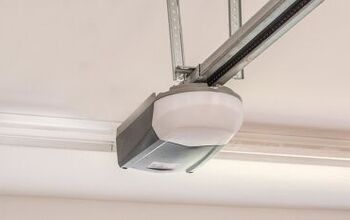Furnace Blower Turns On And Off Repeatedly? (We Have A Fix)

When you install a furnace in your home, you expect it to run for long periods of time. This is especially true when you’re still working on making your home warm. This includes the furnace blower as well. Unfortunately, that doesn’t always happen.
If you have a furnace blower that’s short cycling (turning on and off repeatedly), you probably should be worried. What does this mean?
If your furnace blower keeps turning on and off repeatedly, this is usually an indication that you have a bad fan limit switch. Once you replace the fan limit switch, your furnace should run the way it is supposed to. You can do this yourself or hire an HVAC technician to assist you.
In some cases, noticing furnace blower problems that you have can be a precursor to more dangerous issues or even a sudden break in your furnace. Keep reading our guide to figure out how to make it work.
Do You Need a Furnace Repair Contractor?
Get free, zero-commitment quotes from pro contractors near you.

Before You Begin: Is It The Furnace Blower Or The Furnace?
There is a notable difference between having a short cycling furnace blower versus a furnace. Most people who are not HVAC professionals tend to make the mistake of assuming it’s the furnace blower instead of the furnace itself. When you are trying to diagnose this issue, you need to take time to see if it’s the furnace.
This can be done by turning on your thermostat and watching to see how it’s functioning. If you notice the furnace turning on and off, this is not the article for you. This is about the blower that distributes the hot air, not the generator of the hot air itself.
How To Troubleshoot A Short Cycling Furnace Blower
Once you have double-checked and made sure that it’s the furnace blower that is causing all your woes, it’s time to do a little troubleshooting. Here’s how:
- Start by cleaning your air filters. While this *technically* doesn’t lead to a fix for most short cycling furnace blowers, it still can help with most other thermostat problems. More specifically, it can h elp your thermostat function better, which could potentially help squash the issue that is causing short cycling. Check to see if this helps. If it does, it was a thermostat or furnace issue.
- Go to your control board and check the fan speed. See if lowering the fan speed helps. If you recently installed a new fan pulley, try to see if it’s too small for your system. If it is, then the fan was doing overtime which caused the blower to short cycle out of stress to the system.
- Then, go to your furnace burner to see if everything looks alright. If you notice excess dirt, a weak flame, or anything out of the norm, then it was the furnace burner rather than the blower. While most burner issues can be picked up by watching it cycle, not all do, so don’t feel bad about this. Just call an HVAC guy and get this fixed.
- Next, check your heat exchanger. Is there a lot of dust or grime there? Use a cloth to wipe it down. You might see an improvement in your furnace blower’s functionality. If your heat exchanger has a lot of slats, using a vacuum can help remove all the dust.
- Feel the air in and around your heat exchanger. A common reason for a short cycling blower deals with extreme heat or cold in the heat exchanger. If you notice this, then you may need to fix the heat exchanger portion of your furnace or even replace it. This is especially true if you notice a problem with the exchanger while your home’s temperature is exceedingly warm.
- Check your blower’s fan limit switch. The fan limit switch is the most likely culprit of a rapid cycling blower. It’s what directs the frequency of your fan’s work. When it goes bad, it will start to short cycle or will start to run continuously regardless of the temperature in your home. Should this happen, replacing it is the best possible choice.
- If the fan limit switch is fine, then check your vents. Believe it or not, leaks in your vent system can cause short cycling. This is because your furnace blower is programmed to shut off when it detects a sudden gust of cold air in your system. If you’re dealing with chilly weather, you may have an open vent that’s seeping icy air into your home. Patching it with duct tape can help immensely.
What Should You Do If You Did All The Troubleshooting Steps But Still Have Furnace Blower Problems?
This is a toughie. You might have latent electrical problems or control panel issues that may require deeper inspection. In many cases, this will lead to you needing to replace a furnace blower, or the actual furnace itself. It all depends on what the HVAC pro finds to be wrong in your system.
A furnace control panel that’s having problems is something that may require a furnace replacement. The control panel acts as the heart of your heating system, and if it’s malfunctioning, you may not be able to fix it on your own. Even pros can’t always fix these kinds of issues, so replacement is the go-to solution.
Bottom line here? You probably will have to talk to an HVAC professional, or you might have a furnace blower that has gone bad. You can read up on furnace blower motor problems here, if you need to get a little more educated on the subject.
How Much Does It Cost To Repair A Furnace Blower?
It all depends on what’s wrong with the furnace blower. With most of the issues that we mentioned above, the price won’t be too high. A furnace blower repair can range between $350 to $750 on average, for most homeowners. Choosing to go it alone is a good idea here, since DIY replacement only costs $100 to $125 for a typical furnace blower.
If it’s a matter of leaky air ducts, you can usually do the fix yourself with a roll of duct tape you have lying around the house. On the other hand, if this is actually a furnace problem that requires a replacement, you will have to shell out between $1792 to $6,900 to get the problem fixed. Ouch!
Why Do Leaky Air Ducts Cause Short Cycling?
Believe it or not, your air ducts make a huge impact on the health of your HVAC system. Leaks in the ducts will cause your thermostat (and other sensors in the system) to give a lower (or higher) than usual reading. Without an accurate reading, your HVAC system has no way to properly regulate the temperature in your home.
A single breeze that hits your air vents can cause your HVAC system to kick on, even if the overall temperature in your home is A-OK. When the breeze ends, the system will register that the temperature is alright, which leads the furnace to shut off. This can lead to fluctuations in your furnace as well as the blower motor.
Due to the damage that leaky air ducts can do to your system, we strongly suggest double-checking your ducts. You might be surprised at how much better your home will be able to function once your air ducts get patched up.
Do You Need a Furnace Repair Contractor?
Get free, zero-commitment quotes from pro contractors near you.

Related Questions
How can I tell if I should repair or replace my furnace?
This is never an easy decision to make. If your furnace repairs would cost more than half of the overall price of a new furnace, it’s usually best to replace it. Replacement is also advisable if your furnace is more than 15 to 20 years old.On the other hand, repair is usually ideal for problems that are deemed “quick fixes.” If your furnace is still under warranty, then the best thing you can do for your home (and wallet) is to get it repaired.
How long does a gas furnace usually last?
Gas furnaces are known for being fairly durable, so if you just got a gas furnace, don’t worry about replacing it anytime soon. Most gas furnaces will be able to last at least 15 to 20 years before they require a replacement.Quality matters when it comes to the type of furnace you buy. Poorly designed furnaces may only last eight to 10 years, even with proper maintenance and warranty repairs. If you get a top-tier furnace, it’s possible to keep it running for as much as 30 years or more.
Is having an old furnace dangerous?
Most people drastically underestimate the dangers of using an old furnace. An old furnace is more likely to leak carbon monoxide, which means that a CO detector is a must. Moreover, older furnaces are more likely to have fire hazards and can even explode. The risk of having a furnace suddenly die also is very real.If you choose to keep an older furnace, it’s imperative that you do regular maintenance and also check its safety features frequently. If your HVAC tech advises you to replace it, listen to them. It may actually save your life.

Ossiana Tepfenhart is an expert writer, focusing on interior design and general home tips. Writing is her life, and it's what she does best. Her interests include art and real estate investments.
More by Ossiana Tepfenhart



















![Standard Dining Room Table Dimensions [for 4, 6, 8, 10 and 12 People]](https://cdn-fastly.upgradedhome.com/media/2023/07/31/9074335/standard-dining-room-table-dimensions-for-4-6-8-10-and-12-people.jpg?size=350x220)







